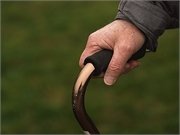- Understanding the Connection Between Anxiety and Depression
- How Daily Prunes Can Influence Cholesterol and Inflammation
- When to Take B12 for Better Absorption and Energy
- Epsom Salts: Health Benefits and Uses
- See What Saffron Can Do for Sleep and Heart Health
- 6 Common Mistakes to Avoid Before Your Physical
- Can Sweating Really Help You Beat a Cold?
- Strengthening Your Relationship: Practical Strategies
- Skip Storing This Everyday Product in the Fridge Door
- Green Tea + B3 Pairing May Boost Brain Health
One-Time Treatment Eases Parkinson’s — in Mice

In findings that could pave the way to a new treatment for Parkinson’s disease, scientists have figured out how to spur the production of new brain cells in mice.
The advance centers on a protein found in various cells in mice and humans. Researchers found that blocking it in the mouse brain caused certain “support cells” there to transform into specialized neurons that produce the chemical dopamine.
In Parkinson’s disease, dopamine-producing brain cells gradually die off, leading to movement symptoms like tremors, stiff limbs and coordination problems.
In the new study, lab mice that grew new neurons also showed improvements in Parkinson-like movement problems.
Experts stressed that mice, of course, are not humans. And much more research is needed to see whether the approach could be safe and effective for people with Parkinson’s, or other degenerative brain diseases such as Alzheimer’s.
“But the prospect of using this general approach is exciting,” said James Beck, chief scientific officer for the Parkinson’s Foundation.
Beck, who was not involved in the research, said the work fits into a broader concept called “transdifferentiation” — where one type of cell in the body is coaxed to convert into a different type. In theory, the approach could be used to replace damaged tissue in a host of conditions, from heart disease to diabetes to spinal cord injuries.
“It’s exciting to think about the possibility of taking cells that are already in place in the body, and converting them into a different type of cell,” Beck said.
The new study began with a chance discovery. Senior researcher Xiang-Dong Fu, a professor at the University of California, San Diego, had been studying a protein known as PTB for decades. PTB influences which genes within a cell are turned “on” or “off.”
A few years ago, Fu’s lab was studying the workings of PTB in connective tissue cells called fibroblasts, and a member of his team suggested an alternative method: Creating a line of fibroblasts that permanently lacked PTB.
What happened next was completely unexpected, Fu said: After a couple of weeks in the lab dish, nearly all of the fibroblasts had converted into neurons.
Fu said his first thought was, “Wow.”
PTB exists in many types of cells, but not in neurons, Fu explained. Instead, it seems the protein tells the genes within a cell whether it should become a neuron or not.
“It’s a master regulator of neurogenesis that we just stumbled upon,” Fu said.
That naturally brought up the question of whether silencing PTB might produce new neurons in a diseased brain. As an initial step to find out, Fu’s team turned to a mouse model of Parkinson’s.
The researchers took a non-infectious virus — basically a viral “shell,” Beck explained — and outfitted it to carry an artificial piece of DNA designed to deplete PTB within cells. They delivered it directly into the midbrain of the lab mice.
The treatment worked: It turned a subset of the animals’ astrocytes — support cells in the brain — into dopamine-producing neurons. From there, brain dopamine levels rose, and the animals’ movement symptoms resolved.
The findings were published June 24 in the journal Nature.
Many questions must be answered before the approach can be studied in humans. Fu said the next step is to figure out what treatment “dose” is optimal in lab mice, and eventually it will have to be studied in larger animals.
A major safety question, Fu said, is whether there is a risk of producing too many dopamine neurons.
Overgrowth of neurons in the brain would be bad, Beck agreed. “You have to be sure the process is reliable and safe,” he said.
Beck also stressed the limitations of a therapy that replaces dopamine neurons. “It would not be a cure for Parkinson’s,” he said. “It would address symptomatic relief.”
That’s because Parkinson’s is a brain disease, and not only a disease of dopamine loss, Beck explained. So replacing dopamine neurons would not be a magic bullet.
In addition, Parkinson’s symptoms are not only movement-related. They range widely and include depression, irritability and trouble with memory and thinking skills.
Replacing dopamine neurons could be expected to ease movement symptoms — as current medications that boost dopamine do, Beck said. Those drugs do not, however, improve non-movement symptoms.
But these early findings could have implications beyond Parkinson’s disease. Fu said the same approach to blocking PTB could also be tested against other conditions where neurons die — including Alzheimer’s, Huntington’s and stroke.
More information
Visit the Parkinson’s Foundation for more on Parkinson’s disease.
Source: HealthDay
Copyright © 2026 HealthDay. All rights reserved.










